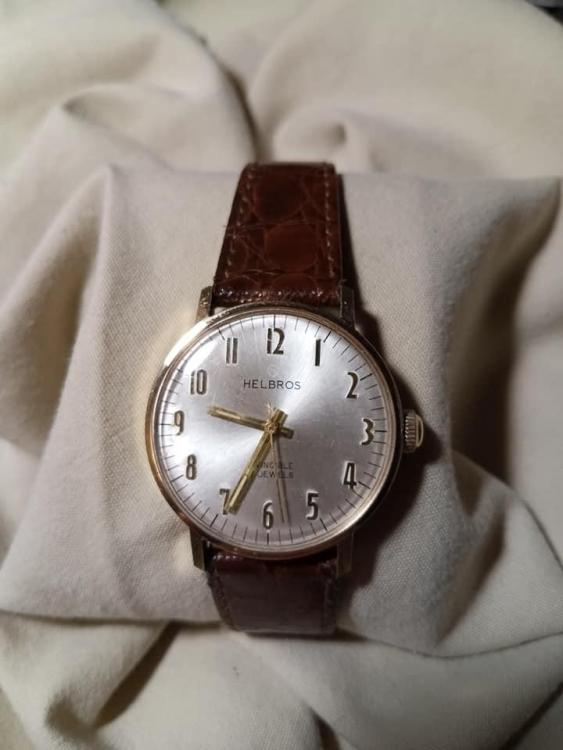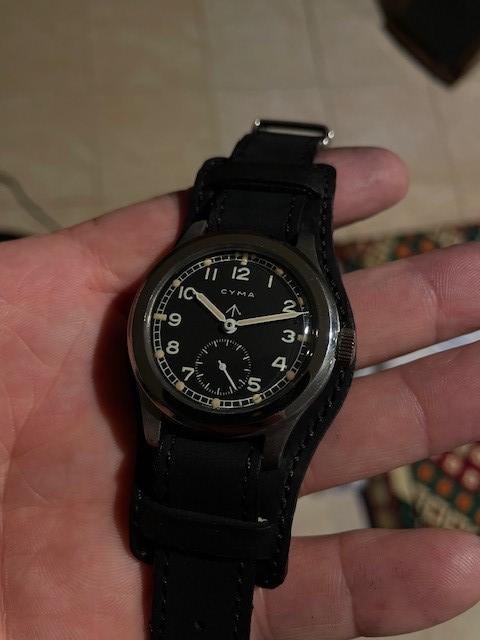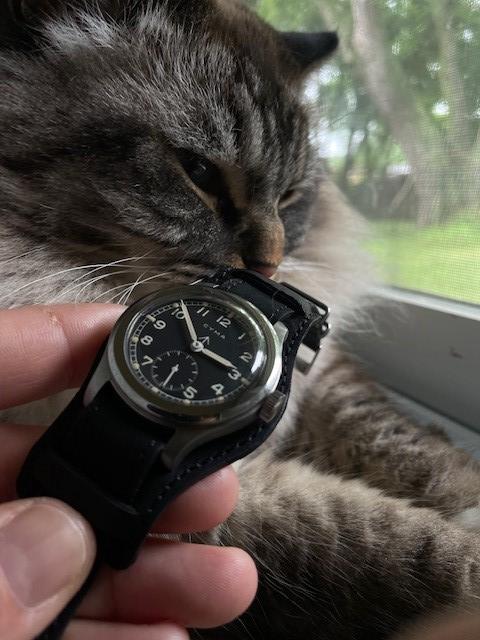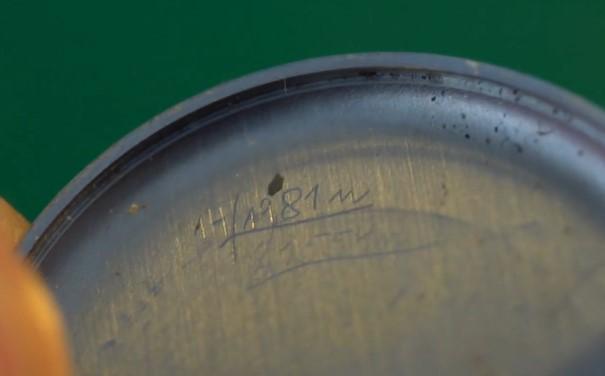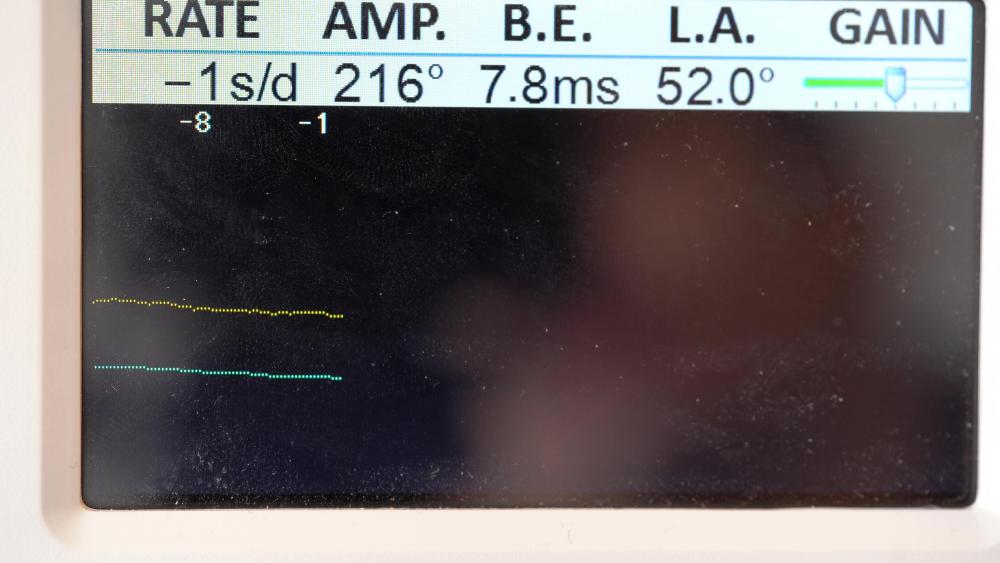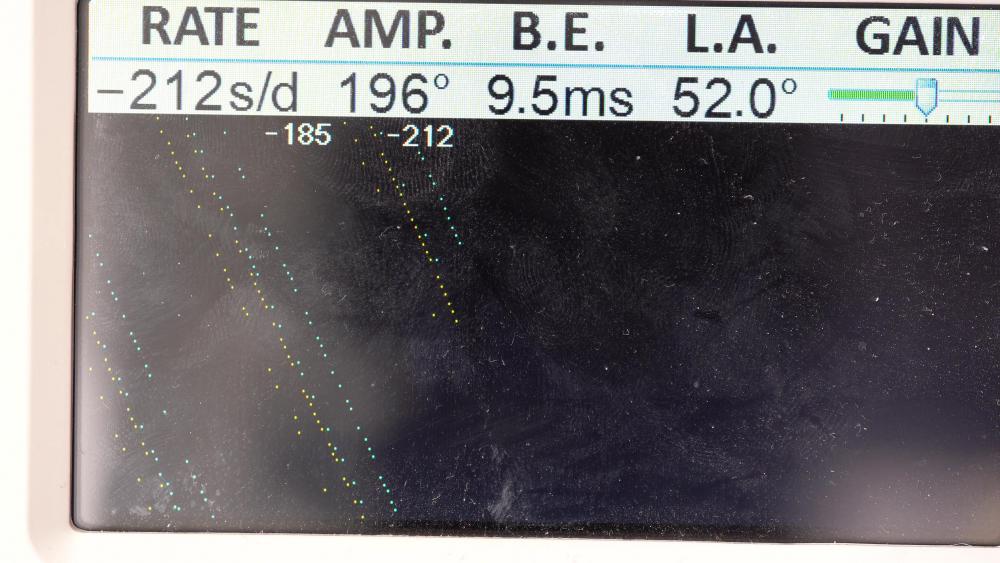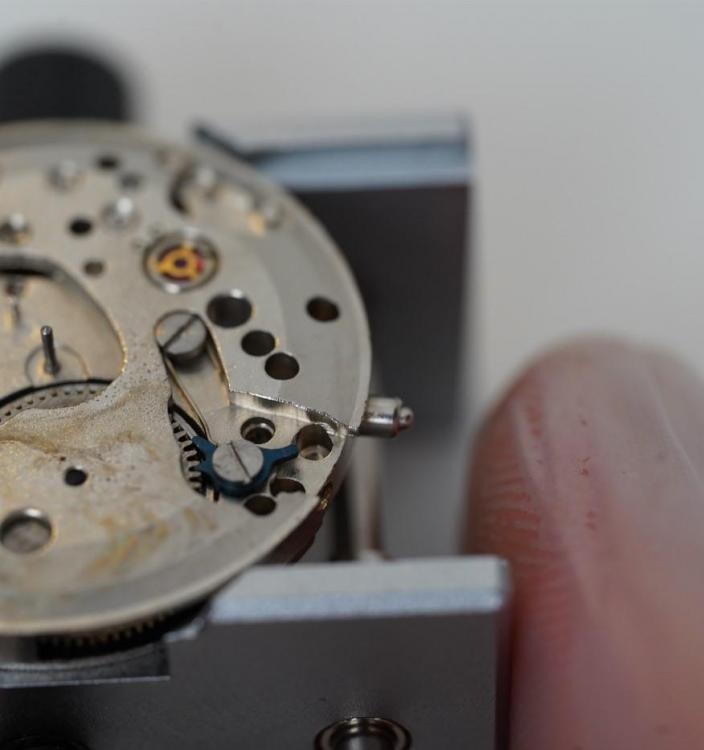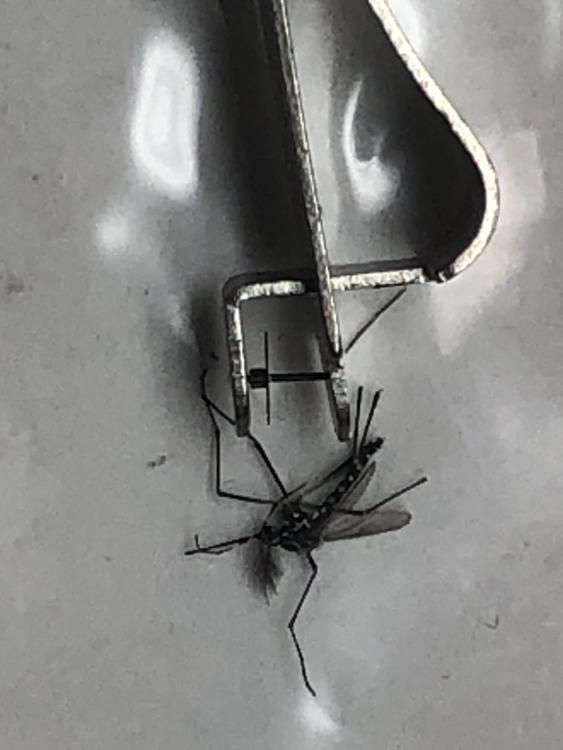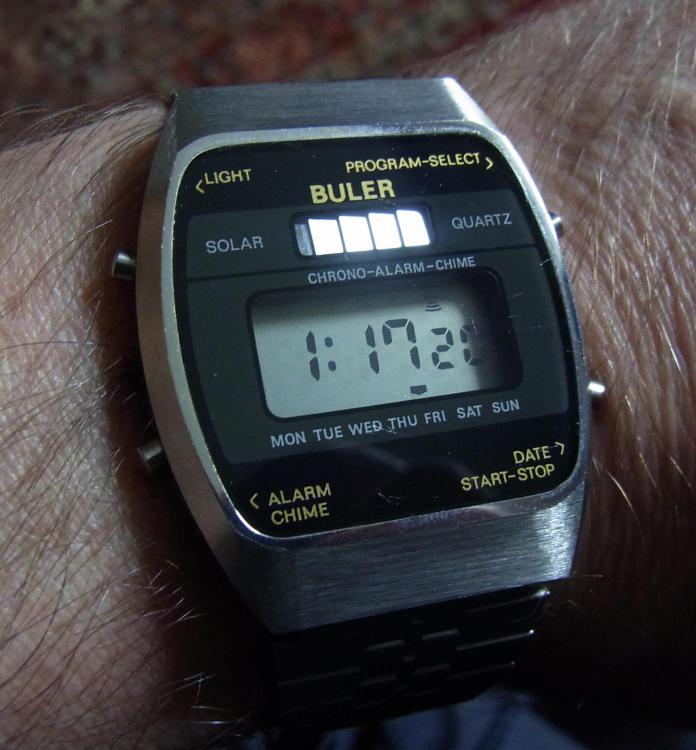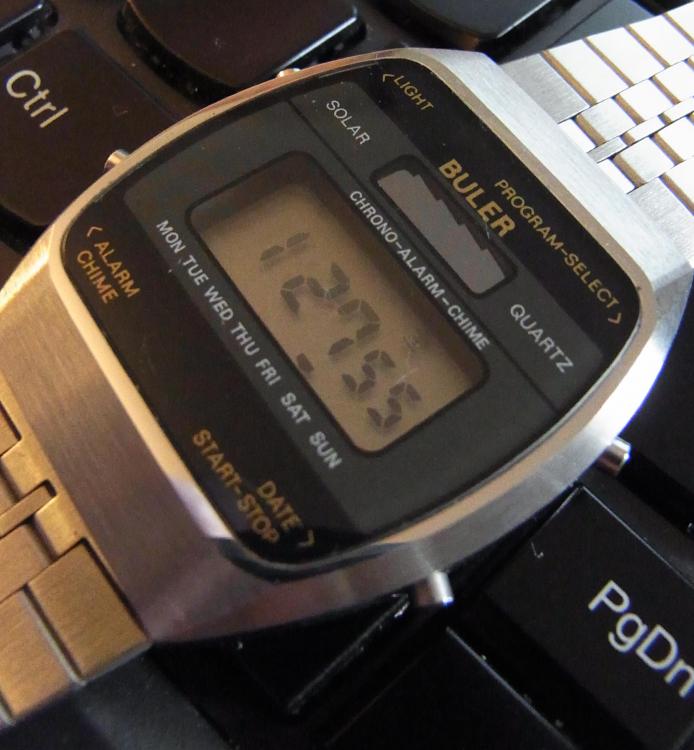Leaderboard
Popular Content
Showing content with the highest reputation on 07/16/22 in all areas
-
In the "THAT NEVER HAPPENS!!!" category of watch repair, I have this new story to add: I picked up this old, dirty Helbros Invincible at a flea market because I liked the style and wanted to see if I could do anything with it. I got it home and took off the back...and it was like opening Pandora's box! Looking over the Helbros-branded Lorsa P72 movement, I could plainly tell that someone had been allowing a stray screw or metal component to just freely go romping about amongst the wheel train. Damaged wheel teeth, scratches, broken staff, messed up hairspring, a couple cracked jewels, but no sign of a loose screw or part - although!...there were two empty screw holes, one in a bridge and it was missing one of the dial foot screws. So I picked up another Lorsa P72 movement off Ebay that seemed to have everything I'd need (it had rust on the parts near the stem hole, but I was not worried about that). When the donor movement came, I just cleaned everything and rebuilt choosing the best parts of each. Ended up replacing the balance complete, center wheel, third wheel, two jewels, and the missing screws. Miraculously, the other wheels were undamaged; teeth, leaves, and pivots were fine. Once assembled and oiled, I set the stud carrier as close to where it should be as I could get it, and put the regulator dead center. Now, I only have a timegraphing app on my phone (limited funds you know). But the traces looked really good. So I've been wearing it off and on, and keeping it wound. Here's the dumb luck part - I haven't needed to regulate this thing yet! It's been two days, a shade over 48 hours, and it is now about 3 seconds faster over that time period. I need to read the specs on a Lorsa P72, to see if it can do any better but, so far, a gain of only 3 seconds over a 48 hour period doesn't sound terrible. I'm used to antique pocket watches and their eccentricities, so having a watch run this close to dead-on without having to regulate it six ways to Sunday feels a lot like a miracle to me. I'm starting to really adore this wrist watch.4 points
-
Based on feedback from @AndyShap, I have included the setter-bowl as part of the latest v0.8 release for the rs winder project, along with various other fixes based on user feedback: https://github.com/vishnu350/rs-mainspring-winder Andy also helped to write a simple guide on how to prepare the staple hook, posted on the wiki section: https://github.com/vishnu350/rs-mainspring-winder/wiki/Creating-the-Arbor-Hook I have also included links to purchase the appropriate dowel pins should anyone want to use that version, its a lot more sturdier than 3D printed arbor rods based on feedback from various users. Will remove the old style bowl eventually since the new setter bowl seems to be so much more intuitive to use. Thanks!3 points
-
Hi This might be of some help Drexler-Elgin.pdf Drexler-School-of-Watch-Repairing-No-1.pdf Drexler-School-of-Watch-Repairing-No-10.pdf Drexler-School-of-Watch-Repairing-No-11.pdf Drexler-School-of-Watch-Repairing-No-2.pdf Drexler-School-of-Watch-Repairing-No-3.pdf Drexler-School-of-Watch-Repairing-No-4.pdf Drexler-School-of-Watch-Repairing-No-5.pdf Drexler-School-of-Watch-Repairing-No-6.pdf Drexler-School-of-Watch-Repairing-No-8.pdf Drexler-School-of-Watch-Repairing-No-9.pdf Drexler-School-of-Watch-Repairing-No7.pdf Gruen-Horological-Text.pdf NY-Clock-and-Watch-Repair-School-pgs-1-28.pdf NY-Clock-and-Watch-Repair-School-pgs-152-175.pdf Ny-Clock-and-Watch-Repair-School-pgs-177-219.pdf NY-Clock-and-Watch-Repair-School-pgs-29-57a.pdf NY-Clock-and-Watch-Repair-School-pgs-98-130.pdf NY-Clock-and-Watch-Repair-School-pgs77-97.pdf Wisconsin-Clock-and-Watch-Repair-Book-II.pdf Wisconsin-Clock-and-Watch-Repair-Book-III.pdf Wisconsin-Clock-and-Watch-Repair-Book-IV.pdf Wisconsin-Clock-and-Watch-Repair-Book-IX.pdf Wisconsin-Clock-and-Watch-Repair-Book-V.pdf Wisconsin-Clock-and-Watch-Repair-Book-VI.pdf Wisconsin-Clock-and-Watch-Repair-Book-VII.pdf Wisconsin-Clock-and-Watch-Repair-Book-X.pdf Wisconsin-Clock-and-Watch-Repair-Book-XI.pdf Wisconsin-Clock-and-Watch-Rpair-Book-I.pdf WisconsinClock-and-Watch-Repair-Book-VIII.pdf3 points
-
I always suggest starting with a pocket watch (not the fusee tyoe) I have posted my suggestion many times on here, no need to get it working my idea is very much like jdm. They are very much like a basic watch movement only much bigger, you will learn how to use your tweezers and your screw drivers and if you are using an eye glass you will learn how to use that. Learn the names of all the parts. If it come apart take it apart as they say practice makes perfect. I cringe each time I see a new member saying I've got my dads Omega Auto and I intend to make it my first watch repair.3 points
-
I'm sitting in my arm chair drinking my morning tea. Click the link. Look down. That's the exact position my watch is in. Problematic for sure. If you have a timegrapher, I'd be curious about the amplitude. There are a handful of things that could cause that, but you don't want to open the case if you can get it swapped out for a non-defective one. That wouldn't really tell you exactly what was wrong, but would give you an idea for how bad it is when it's still running. I would be pretty aggressive on this one. No reason to eat $170. If they want to be assholes about shipping, there are plenty of places with bigger and more acquisitive audiences where you could let people know how crappy these guys are selling defective watches and refusing to rectify the situation.2 points
-
I must apologize, it had escaped me before that by the pictures you posted we see you have got professional tools, and are are well organized and determined. At this point there is 'only' to verify that your watch is whole and all good except for the broken jewels, which you will need to get, and possibly adapt in size. As said, these are of the rubbed in type, something that has been discussed various times in the past, so use the search function or Google site search. Certainly it would be better if you were to practice first their replacement on a scrap mov.t. As long you are patient and cautious, and able to invest the needed time and money there is no reason why you shouldn't be able to get this watch running within a not too long time, good luck.2 points
-
I think we, as commentators, have a responsibility too. As was mentioned, we must consider the expectation of the learner. Whether a learner has a preference to learn on an old pocket watch movement that does not run, or on a new but inexpensive watch that runs, the rest of us should take that preference into account when we give advice to encourage one thing, or discourage another. We've been down many of the pitfalls that the learner has not, but our warnings about them should be voiced in as gentle a way as possible; it is hard to guess one's tone of voice from the printed text. If a learner decides to start with an inexpensive non-running pocket watch, we should gently remind them that the greater goal of learning good habits and proper procedures supersedes any goal of getting the thing running. If the learner does get it running later, then that's "icing on the cake", but even if it is not running in the end, the learner will still understand that there was much knowledge gained along the way, and that knowledge and practice was important. And at the very least, the learner can learn what was needed in order for that watch to run. If a learner decides to start with an inexpensive new movement that runs, then learning about repair will still happen and, unless something breaks, if the watch runs properly at the end, then learner will know what they did to make it so. And if not, then the learner will know the potential is there, and they can continue to work and learn until the watch does run. There are benefits to either path. For my humble contribution, I think the only kind of movements I'd discourage a learner from buying for practice are: repeaters, chronographs, things with day & date, brand new Rolex, an expensive family heirloom with low production run, or something obscure like a Grasset with a helical mainspring or a Breguet with a ruby cylinder. The vast majority of timepieces fall outside of that short list, so there are still plenty to choose. But our guidance can emphasize the positives of the experience, even where the learner fails to accomplish a result they had in mind. And practice, good and proper practice, learning good habits from bad and so forth, is an incredibly valuable thing here. A difficult watch can discourage some of the most determined individuals; we experienced folk should do all we can not to become an additional source of discouragement.2 points
-
Yes I did. Don't get me started. I tend to swear in German if I think the kids might hear. I said some foul things a couple of times.2 points
-
I don't agree with the idea that the first watch a beginner attacks has to be a working one. The evidence is a total beginner will typically do many typical mistakes which will turn one into a broken piece of for sure. Working in the wrong position, without a soft mat, on carpt carpet floors. Then being proud of having lost "only one screw". That still one too little in my book. Handling the hairspring / balance with heavy hands, or having "unfortunate accidents" and driver slips. One can't realize how delicate it is before trying. I won't link the horror pictures here. Breaking screws because they were not market left. Or because they had to be left, but they were right. Getting impatient or frustrated, then force and break something consequently. Myself for one have do all the mistakes above, and then some of my own creation. If you have any love for your watches, or your reputation if it's not yours, especially about unreplaceable heirlooms or of some value, leave them alone. Practice first on something wortless, even a quartz cheapie, just to learn how to handle tools and parts correctly. Even if you have watches videos that make that look easy, you may find that is not. Sure, that won't tell you if you are able to put back together a working watch. But, that's not all what matters, you will get there eventually, but having spared few innocent victim in the meanwhile.2 points
-
1 point
-
There are seventeen pages of stems in the Bestfit#111 catalogue including the #200 system and the #360 system. Some of the vendors provide access to it. You can purchase access here: https://www.esslinger.com/matsys-online-from-bestfit-lifetime-membership-watch-parts-lookup-software/ I paid less than that for the hardcopy books.1 point
-
Hi Is it possible for you to post a picture of the watch movement. The name on the front does not always represent the movement maker and a picture may help members to Identify the movement and therefore what type of cell it requires. Thank you.1 point
-
Is there an obviously empty location for a battery? You might try getting in touch with them directly here. Found online: "Never use ordinary batteries for your solar-powered watch/clock. A solar-powered watch/clock uses a special rechargeable battery called the "secondary cell." If it is replaced with batteries of different kinds, your watch/clock may be seriously damaged." Have you tried this (found online): "If your solar powered watch has stopped working please pull out the crown/winder on the side to the first or second position, as applicable, and leave it under a light source for 24 hours as the watch may have completely depleted its charge."1 point
-
Yes what Karl just said . Lol. I would have wrote the same but I'm busy kicking the C. Manflu into touch and sorting out 20,000 watch stems. Nicely put buddy1 point
-
Lucky you indeed! That's a nice looking watch. I like that style of dial with those particular Arabic numerals. Girard-Perregaux used that style, probably during the same time period. Caravelle may have used a similar style as well. Wear that Helbros in good health! Cheers.1 point
-
I used to change the words slightly, my children used to think i had an annoyance with a bartender ( steward ) that liked fluffing pillows. That was the best explanation i could give them lol.1 point
-
Dude, if I can also get your watch running spot-on without doing any regulation, I'm going to immediately jump into my car and go buy a lottery ticket. That kind of luck doesn't come around often.1 point
-
For what it's worth: it has now been almost three full days from service, and the watch is not quite 5 seconds fast. Um...wow. I'm not going to touch anything in there again for a long time. It can stay just like that.1 point
-
Hi everyone! This time I'm back again with a little something which turned out to be something of a hybrid project. I had repaired and planned a video on a Junghans watch with the 93 movement caliber to give to my younger brother ( which young adult doesn't need a nice looking watch) and had it all set out, planned and executed. The only downside was that the dial was slightly discolored on the right side due to bad cleaning on my part. Here you can see what I mean by that: But I happened to be at a local fleamarket on the day when I wanted to finalize the video and surprisingly found the exact same model! Even though the crystal was pretty scratched up, I was confident that the dial was in a good condition so I bought it for 10 Euros. And yeah, it looks like I hit the jackpot: So.. I got lucky and changed the dials in the end. But enough rambling around and here is the actual process of working on the watch movement: 1. Removing the movement from the case. This movement was from the “trilastic” model line of junghans and it got its name from the tri-legged support beams which held the movement inside the case. Just pop those up and remove the movement. Fun fact: While checking the inside of the caseback for marking I found one from 1981, thats so coooool! : 2. Remove the hands and and then the dial by unscrewing the dial feet clamps ( Forgot to take Pictures sorryyy) 3. Strap the movement into the holder and unwind the watch if needed. Then I removed the broken watch stem. 4. Remove the blued ratchet and the click spring 5. Remove the hour wheel, minute wheel, canon pinion and the very interesting looking yoke and its spring. 6. Then remove the clutch and flip the movement. The leftover lever will be released from the backside later on. 7. Remove the balance wheel and the pallet fork system. 8. Then remove the two screws holding down the mainplate and lift that. You can go ahead and unscrew the screw in between as well since that will release the left over lever on the front side. Do the same for the mainspring cover. 9. Remove the gear train and the mainspring And that's about it with the disassembly! Now moving on to the whole cleaning, lubrication and servicing part! Mainspring service: This Mainspring was something new to me since it had a very interesting arbor! Instead of the traditional small arbor inside the barrel, it extended outwards and acted as a lid and a wheel at the same time. While this is definitely cool, it also brings some negatives such as faster exposure to dirt and etc with it im sure. It looked fine so I just recleaned, lubricated and reinserted the whole thing: Lubrication: Here is a list of lubrications I used Moebius 9010 - All jewels Moebius 8200 - Mainspring and barrel lubrication Moebius HP 1300 slower moving parts such as canon pinion Moebius 9415 - Pallet Fork hooking jewels Molykote DX - Gearless works and high contact/friction zones (Front side only really) Oh and of course don't forget to clean and lubricate the balance shock jewels! Reassembly: Just reverse the disassembly steps or watch (no pun intended) the video for a step by step walkthrough. Timegrapher Test: Before Regulation After Regulation: Now i'm very happy that the rate is so much better. The amplitude can definitely be better however I would blame the old mainspring for that. The one thing that puzzles me really is the Bear Error. I've tried virtually every combination on the balance but the beat error does not improve. Maybe something is wrong with the hairspring? Final Result: After attaching the more aesthetic dial and recasing the watch and adding the straps, these are the final result pics: I must say I'm very happy with the whole process! Of course there were some up and down moments like when I destroyed the balance ( don't even ask) and had to get a replacement and such things but it all worked out in the end did it not? I was not sure how the beat error and the lower amplitude were going to show themselves while wearing the watch so I did a test wear for a week and the time only deviated by a second or two so I'm relieved! Now I apologize for the lack of pictures for a smooth documentation, I forgot and yeah, the rest is history. However, I have uploaded another fully commentated video so If you want explanations, more information or just a smoother experience go check it out: https://youtu.be/ZDXKiNnrmMk Any criticism, questions, comments and tips are always welcome and i'm happy to talk to you all! Hope you enjoyed it and until next time! Stay Healthy!1 point
-
the best of my knowledge I don't recall ever seeing a service guide or a technical guide for any American pocket watch at least vintage. There will be parts books but they don't cover repair that is covered the parts. As you can see above other people produced service information. then even the U.S. Army was teaching pocketwatch repair and here's their book that you can download. https://archive.org/details/TM9-1575 is there some specific piece of knowledge are looking for?1 point
-
Agree with hippy and jdm here. I think the problem here as Gary has said many times over is the expectation of the learner. And then the disappointment of most likely not seeing it work. But as explained here it does not need to work its a practice piece to learn tool handling at a more managable scale just a big bonus if it does work. Heaven knows why i started at 8 1/4 ligne and then down to one of my missus watches a quartz at only 5 something, the train wheels were ridiculous and the rotor had me pulling my hair out for over an hour ( yes I am an idiot ).1 point
-
Taking the obvious approach first, how sellable do you think Bulova watches are in your location, what research have you done showing there is a demand for this brand that is not being met already by their other dealers. As for making money, how keen are their trade prices, what percentage do you plan to make through your markups, do Bulova dictate minimum or maximum prices you are allowed to charge in their terms of business. Do you plan on holding stock at your expense or just act as a drop shipper and order from Bulova as you sell a watch. There are an awful lot of risks involved in starting and running a business, do your research well and good luck if you do go ahead with it.1 point
-
I'm a bit confused here Hugh ( I'll give you a little while to figure that one, a bright lad like you shouldn't take you very long ). Are you new to watch repair ? Your bench and equipment seems well set up. I have to admit this is exactly how i started, but then I've always been one to jump in at the deep end. Maybe not everyone's approach but it does seem to work for this crazy fool that i am Good lad, bright, intuitive, keen, understanding, honest and appreciative. You are a welcome addition to the forum. Nice one Kappa. The who dares wins approach1 point
-
1 point
-
"The only source of knowledge is experience; good decisions come from experience, and experience comes from bad decisions" I say go for the pocket watch you started. Worst case scenario is you don't fix an already broken watch while gaining a wealth of experience in part finding and trouble shooting. Best case scenario is essentially the same as worst case scenario except you fix a broken watch. Only you know the real reason you started this hobby. Stay true to that you can't go wrong no matter what you decide to do. Measure the jewels you need I have some laying around maybe they will fit. https://sallysales.patternbyetsy.com/listing/526583888/vintage-hallmarked-silver-open-face1 point
-
Thanks for the welcome, HectorLooi. I haven't worked on a 214 yet. It's on my bucket list. Unfortunately, they seem to go for a lot more money than 218 series and such. I had a friend that was into pocket watches when I first got into them in the nineties. Not long after we met, he started going after Spaceview wrist watches. I remember him talking about the "real deal" vs modified versions. I had no interest in wristies at the time, and certainly not electrified watches with weird vibrating forks. What started me down this road/rabbit-hole, was a guy who didn't want to spend what it would take to fix a 2182 that was his dad's. He offered it, gratis, to the first taker. I was the second one who saw it, but the first guy was out of the country and the owner had said he'd only ship to the US. Lucky for me, I think. That 2182 is still not running right, but rather fast and stuttering with a 1.55V battery. I'll probably end up replacing the index wheel. I won't get a good look at the teeth on the existing index wheel until I get my doubling Barlow lens that will take me to 90X magnification. Good luck with your problem-child 214. The 214, Spaceviews in particular, really are the classic Accutron. But the later models did have some nice improvements that apparently made them less finicky to work on. Cheers.1 point
-
Firstly, thank you TJohnR, jdm and grsnovi for your honest advice. It is both appreciated and taken wholeheartedly on board. Let me clarify that when i say; I mean very cheap (but working) and purchased with the exact intention of disassembling and reassembling many many times over, without worrying about anything breaking or getting damaged in the process (which I know will of course happen). I will look to get a 6497 or 6498 clone to add to the mix. Thank you. I love this blunt honesty, and i'm glad i've found a forum where there are people happy to dispense it. I haven't entered into this hobby naively, I appreciate both the steep learning curve and the reality that there are no shortcuts or substitute for (many many hours of) hands-on experience. That's also what makes me want to do it! I suspect it will be months at least before i even thinking about touching a watch i care about even slightly, let alone one i wear Thanks again for all the feedback, I look forward to many further discussions in the future. Cheers, Adam.1 point
-
Welcome to the world of humming watches @MrRoundel. It's really strange that so few people are willing to work on Accutrons but yet every Accutron that appear on eBay gets snapped up. Sometimes at ridiculous prices. The recalcitrant 214 that has been giving problems turned up again. This time the coil on the component side gave up it's ghost. Finally the mystery got solved. The problem was a defective coil which was about to break. I feel relieved and vindicated. Now to hunt for a new coil.1 point
-
I'm not suggesting that you start on a running watch of your own that you wear. If it isn't apparent from what JohnR and jdm have said, you're very likely to trash it. My point was to use the same movement that Mark L suggests be used in his 2nd self-paced, online course. In fact - sign-up and take the course! Follow along with Mark. Having arrived here by watching innumerable YT success videos where NOTHING goes wrong and not a single screw or spring goes awry and the end result is a beautiful, working watch ticking away with only +/- 1 or 2 seconds per day after being serviced by a pro with ALL of the necessary tools - you end up with a skewed idea of how it's going to be the first hundred times. My suggestion is that by picking a 100 year-old watch that isn't running you will first need to figure out why and unless you've worked on some and figured it out you're not likely going to have a clue. Then there's the whole question of parts (which kind of started this back and forth). If you are going to have to buy something to start on, consider that buying a Seagull ST36 may be a better choice than an equally expensive, un-working pocket watch.1 point
-
I found an article suggesting that Ralco were made by Movado. Are there any numbers or letters under the balance which could help identify the movement ?1 point
-
Thanks everyone. Although not needing it really, I like to know as much as I can about things I’m working on. Thanks for the tips. I was happy to find this resource as well http://www.elginwatchparts.com/ Especially since many of my watches are Elgin.1 point
-
1 point
-
While there may not be a specific service guide for this movement, I suspect that you would find the old Chicago School of Watchmaking course handy. It will provide a lot of information on American pocket watch servicing. I believe it's available online somewhere in CD form. I have that, as well as the original hard copy. I think that will be your ticket. Good luck!1 point
-
Yes. By today standars $40 is inexpensive, for an hobby that easily sets one back $200 for very basic tools. But, we also know that there is people that joins with highest ambition without having even tried. Guess what, being good with cars or generic DIY is not enough when it come to watch movements, So all I'm trying to do is convincing people to get a grasp of what's that about without spending any money. So the Chinese Unitas can have a more glorified end being cased, still working, into a custom watch which one can say to have made himself.1 point
-
That name means nothing. Post good pictures of top and dial side with the dial removed, to identify it.1 point
-
For the most part I agree 100% with what you've written. Unfortunately newbies are very very destructive when learning watch repair. there is usually a failure to grasp that watch repair isn't easy it requires time to learn and lots of practice forever you'll be practicing and getting better. then newbies want to jump in right away they don't want to start slow they don't want to practice on a broken watch and if they do start on a broken watch we have a discussion like this where they think they're going to fix the watch. so a clarification on the definition of a running watch to start with. Not just any running watch but a brand-new Chinese clone of the Swiss 6497 or 6498. this watch is chosen because as a large size it's easy to see it's inexpensive and no one cares if it gets destroyed in the process of learning. then the reason for running watch is after a new be practices taken apart and putting it together multiple of times it should still be running. If it's not running because the pivots broken oor the hairsprings destroyed or whatever it was running before and it's not running now well that's a good lesson on why you want to start on something disposable.1 point
-
You don't need anything special. Eg. you can use any nail varnish already in your household. Remember that if the marker has feet the gluing in done on the back, not the dial side.1 point
-
Its nice isn't it . Watch weasol you and me have very good taste . Its part of their heritage classic collection called the Tuxedo. I want one . Around £16001 point
-
This is the posts for a nail clipper tool I designed some time ago with post from LWS for his mods. Maybe of some use. https://www.watchrepairtalk.com/topic/13621-cannon-pinion-tightening-tool/?tab=comments#comment-125998 https://www.watchrepairtalk.com/topic/18130-cannon-pinion-tool/#comment-1553121 point
-
I had similar looking hands on my 7548. I removed the rotted lume and relumed them. The silver plating on the hands is very thin and won's survive any polishing. Some have used Magic Rhodium on the hands to bring back the silver. This product seems to have disappeared from the US market. You can't do anything to repair the pitting. I did just enough to remove the lume and corrosion. The inside edges were gently cleaned as much as possible without disturbing the plating. I have hands that look like they have been around the block but are perfectly readable day and night. I work a lot at night and I need lume. I make no apologies for have watches that are usable. Acetone is the only solvent I've found that reliably removes Seiko lume. Some of the after market hands I have used lately have been junk. They pressed on too easily and thina a tissue paper. On one watch they have slipped out of place and need to be replaced. I'll take worn looking Seiko hands over after market any day. The 7548 and 6309 hands are flat and have sharp edges. Most reproductions have rounded edges and corners that just don't look right. On your bezel, you may find the little plastic circle pushed into the hole. Having that little bit goes a long way to improving the look of the bezel. I use UV cure varnish as used on fishing flies to mix lume paste for these. It waterproofs the lume powder and glues the pip in place.1 point
-
I don't think so. Prior to the explosion of folks (of vastly differing ability, but often generally being perceived as competent to expert) posting videos of watch repair I don't think it occurred to very many people- i.e. next to none- to try repairing watches. When I see some of the videos, which are very popular, and the horrifying "technique" and the ooohing and ahhhing in the comment sections, I think the average affordable vintage watch is at much greater risk now. Just the comment section of the above video is primarily folks who are utterly impressed and making comments about the outlandish cost of professional repair. Then there's one YT channel, from pros who know what they're doing, that has half it's viewers believing that ultrasonics will hurt watch components. So... I've seen plenty of clock repair vids too, also from "professionals" (but far from expert), showing absolute rubbish technique. But if it's Joe from Joe's TicTocShop and he learned it from his father, and the viewer is a rank amateur, it probably looks like a great idea to punch around holes and fill things up with soft solder and use transmission fluid in the barrel etc. etc. etc. Probably going to sound like a grumpy old man here, but when I got into watchmaking I went to the library and read every book they had on it. Yes, DeCarle and Fried are a bit dated now (and were 25 years ago too), but when I finally made contact with some local watchmakers I could speak intelligently about different aspects and components, and I'm sure if I had been transported to 2022 to watch a bunch of the YT vids I would have a similar opinion as my future self. Also having read those books and yes, indeed, having worked on some flea market watches (with proper screwdrivers and tweezers, and they were also expensive then) I was way ahead in school when I made it there.1 point
-
Thanks very much for your post. I got a Junghans with the very same movement, this post and the video will help a lot to the restoration of this time piece. Best....1 point
-
\ Buler Solar LCD Chronograph Alarm (3091-9003), circa 1978. This was presumably meant to compete with the likes of the Seiko LCD Solar Alarm Chronograph A156 produced the same year. It has all the look and feel of a quality watch, entirely stainless in construction. Very different from the 99 pence "Hong Kong specials" that you could pick up from a filling station a few years later.1 point
-
Hi I have attached the raketa tech sheet for reference, unfortunatly it has no exploded diagram and therefore may not be of much interest to you except for future use regarding parts and numbers. Raketa 2609A.pdf 4328_Raketa 2603.pdf1 point




